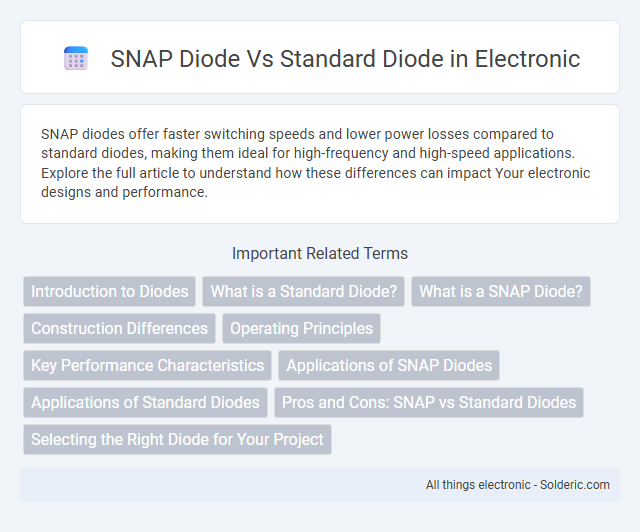SNAP diodes offer faster switching speeds and lower power losses compared to standard diodes, making them ideal for high-frequency and high-speed applications. Explore the full article to understand how these differences can impact Your electronic designs and performance.
Comparison Table
| Feature | SNAP Diode | Standard Diode |
|---|---|---|
| Full Name | Self-Alignment Process Diode | Conventional PN Junction Diode |
| Switching Speed | High-speed switching | Moderate switching speed |
| Manufacturing Process | Advanced self-alignment technology | Standard photolithography and diffusion |
| Applications | High-frequency circuits, RF applications | General-purpose rectification, signal control |
| Forward Voltage Drop | Lower forward voltage drop | Typical 0.7V (Silicon diode) |
| Size | Compact, optimized layout | Varies; generally larger footprint |
| Reliability | Higher reliability in high-frequency environments | Standard reliability for general use |
Introduction to Diodes
SNAP diodes and standard diodes serve essential roles in controlling current flow within electronic circuits, with SNAP diodes specifically designed for high-speed switching due to their fast reverse recovery time. Standard diodes, such as silicon PN junction diodes, typically provide efficient rectification and signal demodulation but may exhibit slower switching performance. Understanding the differences in switching speed and recovery characteristics helps optimize your circuit design for applications requiring rapid switching response or general rectification tasks.
What is a Standard Diode?
A standard diode is a semiconductor device that allows current to flow in one direction while blocking it in the opposite direction, primarily used for rectification in electronic circuits. It typically consists of a p-n junction that exhibits a forward voltage drop around 0.7 volts for silicon-based diodes. Unlike SNAP diodes, which are designed for fast switching and minimal storage time, standard diodes operate with slower response times and are suited for general-purpose applications.
What is a SNAP Diode?
A SNAP diode is a semiconductor device designed for ultra-fast switching applications, leveraging a parasitic bipolar transistor reset mechanism to achieve rapid turn-off times. It utilizes a specialized semiconductor layer structure that enables its unique snap-off characteristic, significantly reducing switching losses compared to standard diodes. This technology is critical in circuits requiring high-frequency operation and minimal reverse recovery time.
Construction Differences
SNAP diodes utilize a unique semiconductor structure with an intrinsic layer sandwiched between highly doped regions, creating a sharp negative differential resistance characteristic. Standard diodes typically consist of a simple p-n junction formed by directly adjoining p-type and n-type semiconductor materials. The intrinsic layer in SNAP diodes allows faster switching speeds and improved performance in high-frequency applications compared to the simpler design of standard diodes.
Operating Principles
SNAP diodes operate based on the principle of snap-off or snap-back behavior in their current-voltage characteristics, leveraging a controlled avalanche effect to rapidly transition between on and off states. Standard diodes function through the p-n junction rectification process, allowing current flow in one direction while blocking it in the reverse. The distinct operating principles of SNAP diodes enable faster switching speeds and higher power handling compared to conventional p-n junction diodes.
Key Performance Characteristics
SNAP diodes exhibit faster switching speeds and lower power dissipation compared to standard diodes, making them ideal for high-frequency applications. Their unique structure reduces charge storage, resulting in minimal reverse recovery time and improved efficiency in power electronics. Your choice of diode impacts circuit performance, especially in switching and rectification tasks where speed and energy efficiency are critical.
Applications of SNAP Diodes
SNAP diodes are primarily used in high-speed switching applications due to their rapid recovery time and low reverse recovery charge, making them ideal for power electronics and RF circuits. Compared to standard diodes, SNAP diodes excel in reducing switching losses and electromagnetic interference, enhancing the efficiency of inverters, rectifiers, and snubber circuits. Your electronic designs can benefit from SNAP diodes when precise, fast switching and improved thermal performance are critical.
Applications of Standard Diodes
Standard diodes are widely used in power rectification, signal demodulation, and voltage regulation due to their reliable, low-cost performance in converting AC to DC. They serve as essential components in power supplies, battery chargers, and electronic circuit protection. Their ability to handle moderate switching speeds and continuous forward current makes them ideal for general-purpose applications compared to the specialized switching capabilities of SNAP diodes.
Pros and Cons: SNAP vs Standard Diodes
SNAP diodes offer faster switching speeds and lower reverse recovery times compared to standard diodes, making them ideal for high-frequency applications and power circuits requiring efficient switching. However, SNAP diodes typically have higher forward voltage drops and can be more expensive than standard diodes, which might affect overall energy efficiency and cost-effectiveness in low-frequency or general-purpose tasks. For your design, choosing a SNAP diode enhances performance in dynamic circuits, while standard diodes provide reliability and affordability in less demanding conditions.
Selecting the Right Diode for Your Project
SNAP diodes offer faster switching speeds and lower reverse recovery times compared to standard diodes, making them ideal for high-frequency applications such as RF circuits and switching power supplies. Standard diodes provide cost-effective, general-purpose rectification suitable for low-frequency or less demanding projects. Selecting the right diode for your project depends on requirements like speed, efficiency, and voltage ratings, where SNAP diodes excel in performance-critical designs while standard diodes serve well in basic rectification tasks.
SNAP Diode vs Standard Diode Infographic

 solderic.com
solderic.com